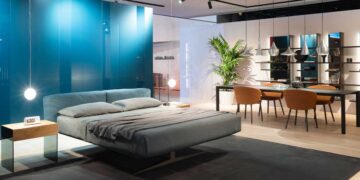
“Small” is a subjective term, but the principles of making the most out of small spaces (whatever that means for you) are not. It all comes down to a few key principles: creative and efficient use of space, using the verticals, smart storage, avoid turning the apartment into a claustrophobic “hub”.
The good news is that the furniture industry recognized the need for multipurpose pieces created by people flocking to big cities.
Today, we’ll offer some actionable tips for making the most out of cozy studio apartments:
Using color with a twist
It’s no secret that light spaces feel “roomier” and, for most people in small apartments, white will be the go-to color. However, there is a way to trick the eye even further. No matter how small the room is, you can always add depth by making one of the walls just a shade or two “darker.”
For example, you can go with ivory for three walls and beige for the fourth (usually the one facing the door). A monochromatic color scheme like this will not be boring like an all-white might be. It will add a touch of pizzazz while remaining elegant and not making the space appear “busy.”
Dividers are your friends
No matter how small the space, using dividers to create dedicated areas will give it more of a homely feel. The choice of a room-divider is up to you, and it can be anything from a Japanese-style screen to a bookshelf.
However, we would recommend the latter…for a few reasons. A bookshelf will do its job without its room-dividing “mission” being obvious. It creates a more welcoming feel and, finally, it has a purpose on its own which means no space is wasted.
Hideouts – aiming for the minimal
When we talked about color, we mentioned a “busy” look. If there’s anything you want to avoid when working with a small space, it’s the claustrophobic feel of too many things “happening.” This perception is usually present in spaces overcrowded with details. It’s common sense to be conservative with adding any piece you don’t need, but that’s not what we want to address here.
What we’re talking about is being smart about storing and “hiding” things. For example, you might go with the sitting ottoman instead of a chair, because it makes a great storage unit. Get creative with this, use any means available to conceal anything but statements pieces. Installing curtains is a great way to do this. If you can achieve a minimal look, with only the bare essentials visible, it will make all the difference.
Sleeping arrangements
Ideally, you’ll want as few fixed pieces of furniture as possible. Doing that gets tricky when it comes to sleeping arrangements, but you still have a range of options.
People living in extra small apartments most commonly opt for wall beds – these are units that you fold back into a wall fixture when not in use. The downside here is that wall beds with comfortable mattresses are expensive.
The alternative – an air mattress
If you don’t want to break the bank by investing in a high-quality wall mattress and your futon/sofa is not comfortable enough for long-term sleep, the best alternative is an air mattress. These have gone a long way from being cheap pieces of plastic and, today, the best air mattresses can offer you the comfort similar to that of a classic bed. The best part is, come morning, you simply pack them away into some closet corner.

Going 3D
Going vertical with your storage is a must. Consider turning one of the walls into a mega floor-to-ceiling shelf. It might “bite in” a few inches into the space, but it can be your storage solution for anything, from kitchenware to linen.
This will probably mean investing into a custom-made fixture but, in the long run, it will be worth every dime. If you’re handy and can DIY, you’re golden. It certainly beats dozens of boxes spread around the place.
Visual flow
Probably the most common mistake people make when furnishing a small apartment is not having a wholesome plan. We understand that you might not have the time or the money to do it all at once, but every project should fit into a master plan you have for the space.
The goal of that is visual continuity, which is the only way to create a relaxing environment. Life happens, we get that. It’s easy to just go with the flow and solve problems as they appear. That’s fine as long as it’s a part of a bigger scheme. Otherwise, you’ll end up with a “chunky” space that confuses the eye. It’s not as difficult as it sounds – it comes down to using color and patterns wisely.
Back to you
If you know your basics, have a plan and stick to it, there are a few ways you can go wrong. The first step is to visualize the look you’re going for and reverse-engineer the concept by following the principles we outlined above. Just as important, don’t think of it as a job and have fun in the process.
Images from Loft in Manhattan’s Upper East Side by Taylor Spellman on archiscene.net



















